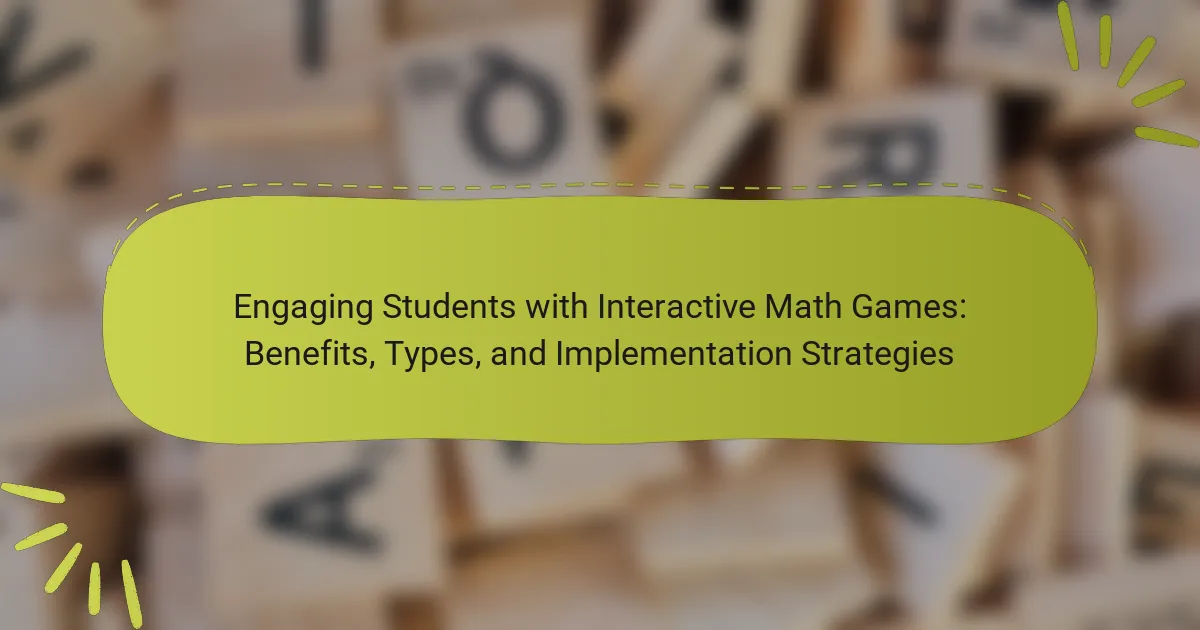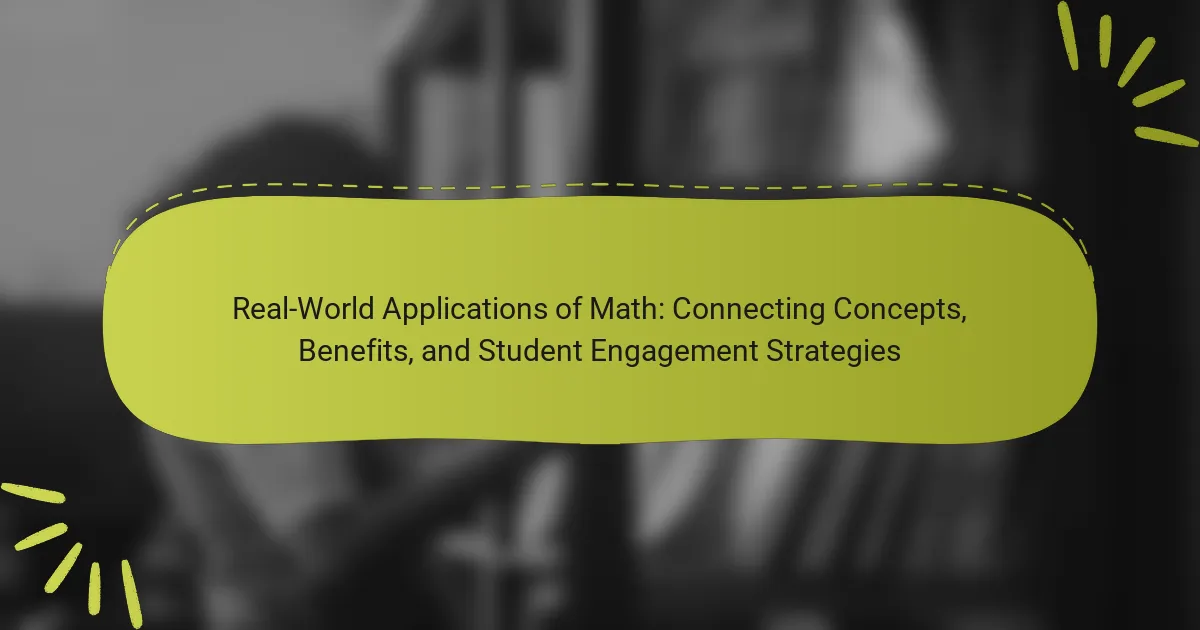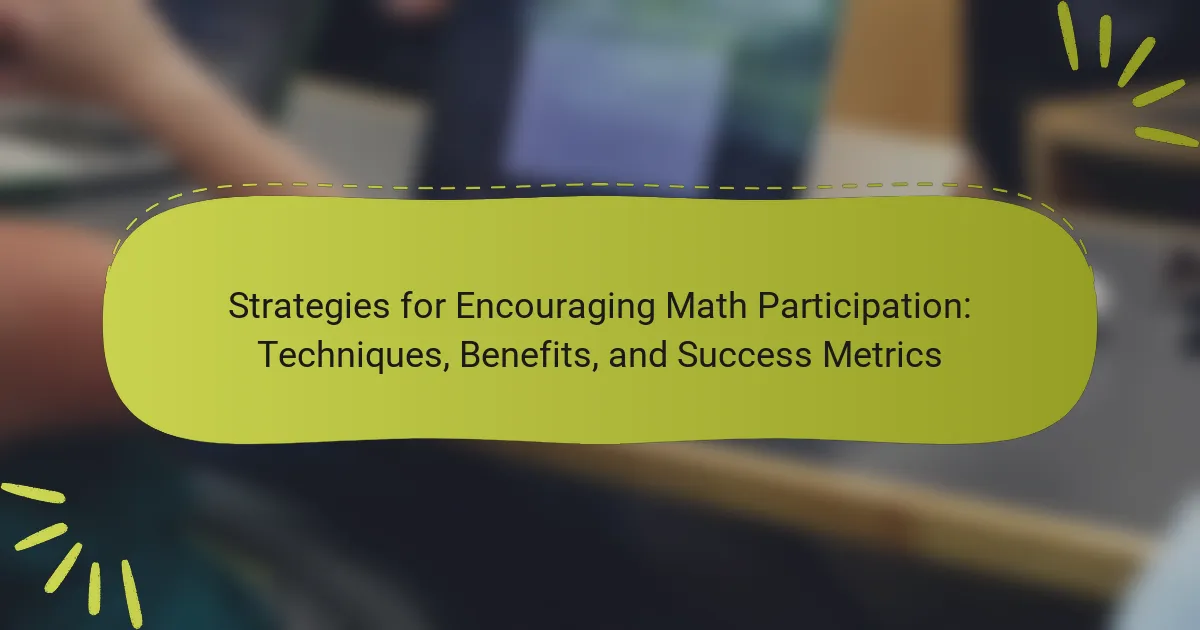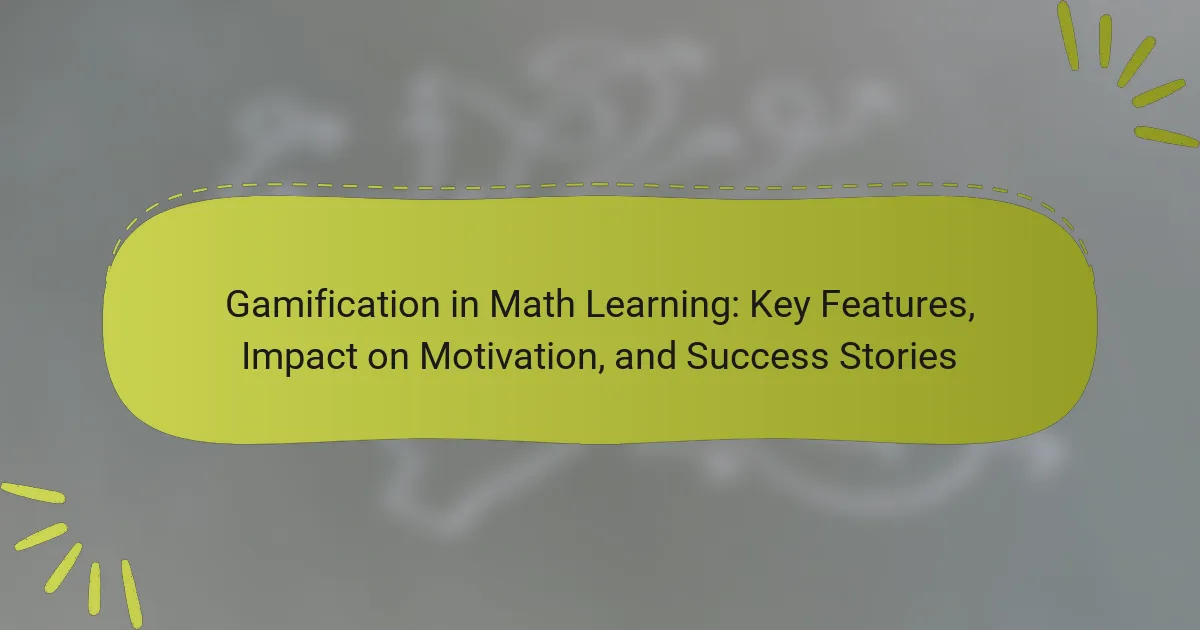Peer tutoring is a collaborative educational approach that significantly enhances math skills among students. Research indicates that students participating in peer tutoring experience improved problem-solving abilities, higher math test scores, and increased confidence in their mathematical capabilities. Effective methods employed in peer tutoring include collaborative problem-solving, reciprocal teaching, structured tutoring sessions, modeling strategies, and formative assessment. These methods not only deepen understanding of mathematical concepts but also improve communication skills and foster a supportive learning environment. Overall, peer tutoring creates positive experiences for both tutors and tutees, leading to enhanced academic performance and social interactions.
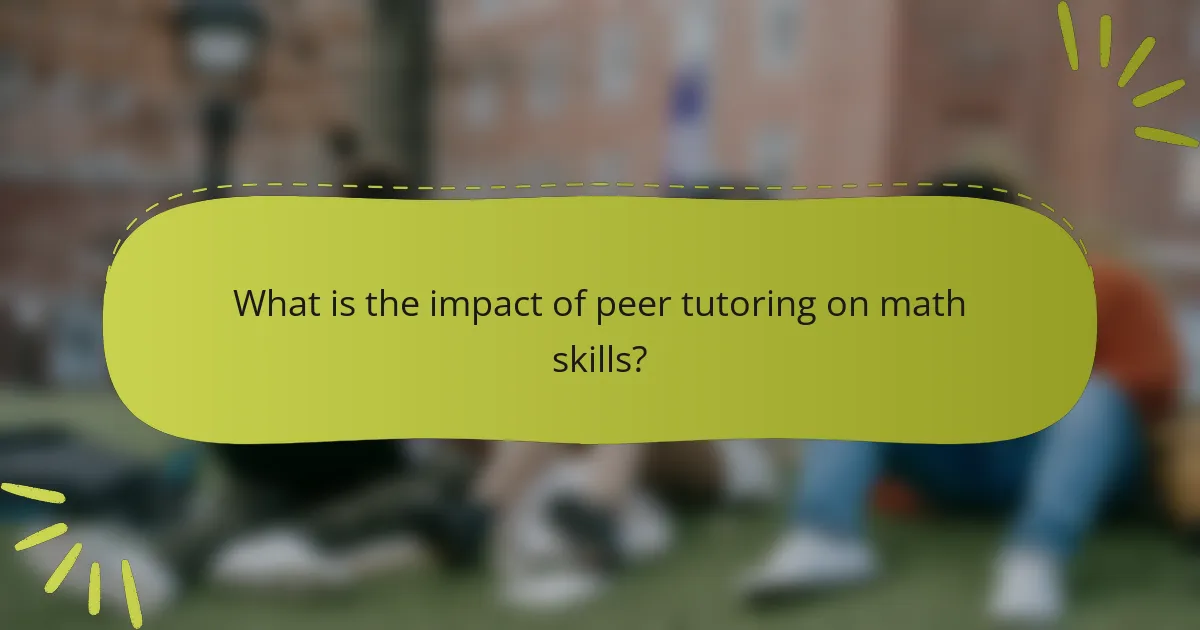
What is the impact of peer tutoring on math skills?
Peer tutoring significantly enhances math skills among students. Research indicates that students engaged in peer tutoring show improved problem-solving abilities and higher math test scores. A study by Topping (2005) found that peer tutors often gain a deeper understanding of math concepts. This occurs as they explain and clarify material to their peers. Furthermore, peer tutoring fosters positive attitudes toward math. Students involved in such programs report increased confidence and motivation in their math abilities. Overall, the collaborative nature of peer tutoring creates an effective learning environment that benefits both tutors and tutees.
How does peer tutoring enhance math skills among students?
Peer tutoring enhances math skills among students by facilitating collaborative learning. In this setting, students explain concepts to each other, reinforcing their understanding. This method promotes active engagement with the material. Research indicates that peer tutoring can improve problem-solving skills and conceptual knowledge. A study by Topping (2005) found that students involved in peer tutoring showed significant gains in math performance. Additionally, peer tutors often gain confidence and mastery of the content. This mutual benefit creates a supportive learning environment. Overall, peer tutoring effectively boosts math skills through interaction and collaboration.
What specific math skills are improved through peer tutoring?
Peer tutoring improves various specific math skills. These include problem-solving abilities, conceptual understanding, and computational skills. Students often enhance their ability to explain mathematical concepts to peers. This process reinforces their own understanding. Additionally, peer tutoring fosters critical thinking skills. Students learn to approach problems from different perspectives. Research indicates that peer tutoring can lead to improved test scores in mathematics. A study by Topping (2005) found that students engaged in peer tutoring showed significant gains in math performance. These improvements are attributed to increased engagement and collaborative learning.
How does peer tutoring affect different learning styles in math?
Peer tutoring positively affects different learning styles in math by promoting individualized learning experiences. It allows students to engage with material in ways that align with their unique preferences. For example, visual learners benefit from peer explanations that include diagrams and charts. Auditory learners gain from verbal discussions and collaborative problem-solving. Kinesthetic learners thrive when they can manipulate physical objects to understand concepts. Research indicates that peer tutoring can enhance understanding and retention across these styles. A study by Topping (2005) found that students involved in peer tutoring showed improved math performance and greater engagement. This indicates that tailored peer interactions support diverse learning needs effectively.
Why is peer tutoring an effective method for learning math?
Peer tutoring is an effective method for learning math because it promotes active engagement and personalized learning. Students explain concepts to each other, reinforcing their understanding. This approach encourages collaboration, allowing learners to clarify doubts in a supportive environment. Research indicates that peer tutoring can lead to improved academic performance. A study by Topping (2005) found that students involved in peer tutoring demonstrated higher math achievement compared to those who did not participate. Additionally, peer tutors often enhance their own understanding by teaching others. This reciprocal learning process benefits both the tutor and the tutee.
What psychological factors contribute to the effectiveness of peer tutoring?
Peer tutoring is effective due to several psychological factors. One key factor is social interaction, which enhances motivation and engagement among students. When peers tutor each other, they create a supportive learning environment. This environment fosters a sense of belonging and reduces anxiety, leading to improved academic performance. Additionally, the act of teaching reinforces the tutor’s own understanding of the material. Research shows that students who tutor others often achieve higher retention of information. This reciprocal learning process benefits both the tutor and the tutee. Furthermore, peer tutoring can enhance self-esteem as students experience success in helping their peers. Overall, these psychological factors contribute significantly to the effectiveness of peer tutoring in educational settings.
How does peer interaction influence the learning environment in math?
Peer interaction significantly enhances the learning environment in math. It fosters collaborative problem-solving among students. This collaboration encourages diverse perspectives on mathematical concepts. Research shows that students engaged in peer discussions perform better in math assessments. A study by Johnson & Johnson (1999) found that cooperative learning increases achievement and retention. Peer interaction also builds communication skills, which are essential in math. Students learn to articulate their thought processes clearly. This interaction creates a supportive atmosphere that reduces math anxiety. Overall, peer interaction promotes deeper understanding and retention of mathematical skills.
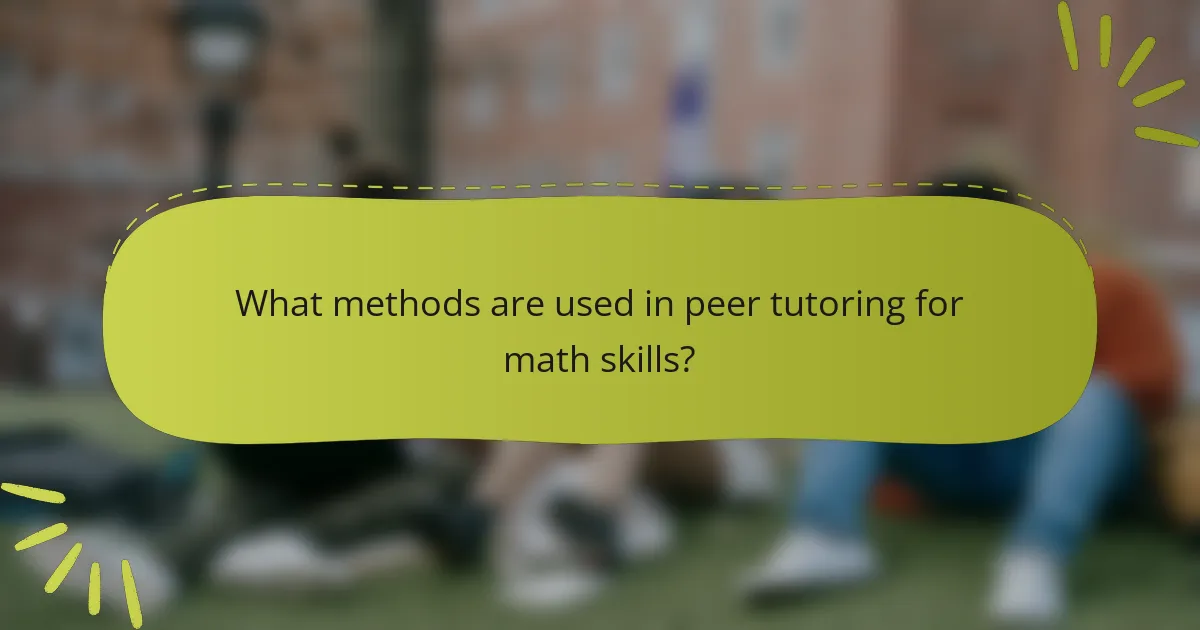
What methods are used in peer tutoring for math skills?
Peer tutoring for math skills employs several effective methods. One common method is collaborative problem-solving. In this approach, peers work together to solve math problems, enhancing understanding through discussion. Another method is reciprocal teaching. Here, students take turns explaining concepts to each other, reinforcing their own knowledge while helping peers.
Structured tutoring sessions are also utilized. These sessions follow a specific format, including assessment, instruction, and practice. This structure ensures that both tutors and tutees stay focused on learning objectives.
Additionally, modeling strategies are employed. Tutors demonstrate problem-solving techniques, allowing tutees to observe and replicate these methods. This hands-on approach boosts confidence and skill acquisition.
Lastly, formative assessment is integrated. Tutors assess tutees’ understanding regularly, adjusting instruction based on performance. This responsive teaching method promotes continuous improvement in math skills.
What are the different models of peer tutoring in math education?
The different models of peer tutoring in math education include reciprocal peer tutoring, cross-age tutoring, and peer-assisted learning strategies. Reciprocal peer tutoring involves students taking turns as tutors and tutees. This model enhances understanding through teaching and learning from peers. Cross-age tutoring pairs older students with younger students, facilitating knowledge transfer and mentorship. Peer-assisted learning strategies utilize structured activities where peers support each other in learning tasks. Research indicates that these models improve math performance and foster positive attitudes towards learning. For example, a study by Topping (2005) found that peer tutoring significantly enhances academic achievement in mathematics.
How do structured versus unstructured peer tutoring sessions differ?
Structured peer tutoring sessions are organized with specific goals and guidelines. They typically involve a predetermined curriculum and defined roles for tutors and tutees. This structure promotes consistency in learning outcomes and enables targeted skill development. Research indicates that structured sessions can lead to higher achievement in academic performance.
In contrast, unstructured peer tutoring sessions are more flexible and informal. They allow students to choose topics and methods of interaction. This format fosters creativity and can enhance student engagement. However, it may result in varied learning outcomes due to the lack of direction.
Studies show that structured sessions often yield better results in terms of knowledge retention and skill acquisition compared to unstructured ones. For example, a study published in the “Journal of Educational Psychology” found that students in structured tutoring environments performed significantly better on math assessments than those in unstructured settings.
What role does technology play in peer tutoring for math?
Technology enhances peer tutoring for math by facilitating communication and access to resources. It enables students to connect remotely through various platforms. Tools like video conferencing allow real-time interaction between tutors and tutees. Online resources provide additional practice materials and instructional videos. Learning management systems can track progress and tailor content to individual needs. According to a study by the University of Michigan, technology integration in peer tutoring increases engagement and improves academic outcomes. This evidence supports the significant role technology plays in effective math tutoring.
How are peer tutors selected and trained?
Peer tutors are selected based on academic performance and interpersonal skills. Typically, candidates must achieve a minimum GPA, often around 3.0 or higher. They undergo an application process that includes interviews to assess their communication abilities. Selected tutors participate in training programs that cover tutoring techniques and subject matter expertise. Training often includes workshops on effective teaching strategies and peer interaction. Additionally, ongoing support and feedback are provided to enhance their tutoring effectiveness. Research shows that well-trained peer tutors significantly improve student learning outcomes in subjects like math.
What qualities make an effective peer tutor in math?
An effective peer tutor in math possesses strong communication skills. They can explain complex concepts in simple terms. Patience is another essential quality. It allows tutors to support students who may struggle with understanding. A deep understanding of math content is crucial. This ensures they can answer questions accurately. Empathy helps tutors connect with students emotionally. It fosters a supportive learning environment. Additionally, adaptability is important. Tutors must adjust their teaching methods to fit individual learning styles. Lastly, enthusiasm for math can inspire students. It motivates them to engage more in their studies. These qualities collectively enhance the effectiveness of peer tutoring in math.
How can training improve the effectiveness of peer tutors?
Training enhances the effectiveness of peer tutors by equipping them with essential skills and strategies. It provides them with knowledge on effective teaching methods. Trained tutors can better understand diverse learning styles. They learn how to communicate concepts clearly. Training also includes techniques for providing constructive feedback. Research shows that trained tutors improve student outcomes significantly. A study by Topping (2005) found that trained peer tutors increased student performance in math by 20%. Overall, training fosters confidence and competence in peer tutors, leading to better academic support.
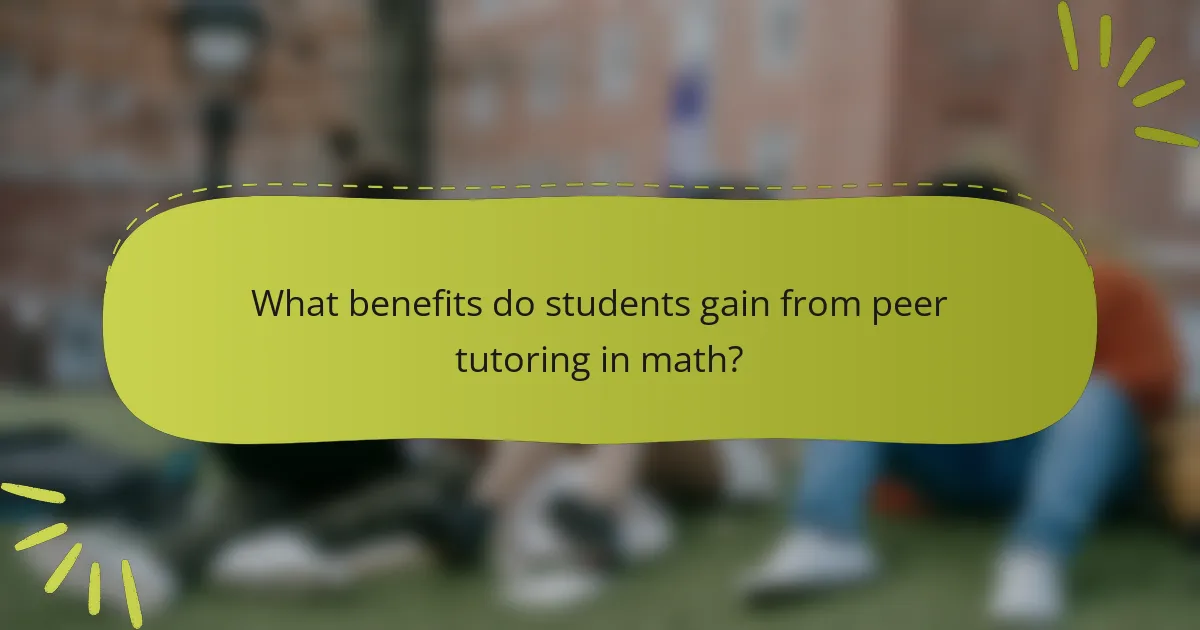
What benefits do students gain from peer tutoring in math?
Students gain several benefits from peer tutoring in math. Peer tutoring enhances understanding of mathematical concepts. It allows students to explain ideas to one another. This process reinforces their own knowledge. Additionally, peer tutoring improves communication skills. Students learn to articulate mathematical reasoning clearly. Research indicates that peer tutors often achieve higher academic performance. A study by Topping (2005) found that students involved in peer tutoring showed improved math scores. Furthermore, peer tutoring fosters a supportive learning environment. It builds confidence in students who struggle with math. Overall, peer tutoring creates a collaborative atmosphere that benefits all participants.
How does peer tutoring affect academic performance in math?
Peer tutoring positively affects academic performance in math. It enhances understanding through collaborative learning. Students often grasp concepts better when explained by peers. This method promotes active engagement and motivation. Research shows that peer tutoring can improve test scores and overall grades. A study by Topping (2005) found that students in peer tutoring programs outperformed their non-tutored peers by a significant margin. Additionally, peer tutors benefit by reinforcing their knowledge. This reciprocal learning process fosters a deeper comprehension of math concepts. Overall, peer tutoring serves as an effective strategy to boost math performance among students.
What evidence supports the academic benefits of peer tutoring?
Peer tutoring enhances academic performance through collaborative learning. Studies show that students who participate in peer tutoring demonstrate improved understanding of math concepts. For example, a meta-analysis by Topping (2005) found that peer tutoring can increase student achievement by an average of 0.5 standard deviations. Additionally, research by Roscoe and Chi (2007) indicates that students who tutor others solidify their own knowledge. This reciprocal teaching method fosters a deeper comprehension of the material. Furthermore, peer tutoring has been linked to higher engagement and motivation in learning environments. Overall, evidence consistently supports the academic benefits of peer tutoring in math skills.
How does peer tutoring influence students’ attitudes towards math?
Peer tutoring positively influences students’ attitudes towards math. It fosters a collaborative learning environment. Students often feel more comfortable asking questions to peers than teachers. This comfort can lead to increased engagement in math activities. Research shows that peer tutoring improves self-efficacy in mathematics. A study by Topping (2005) found that students involved in peer tutoring reported higher motivation levels. They also expressed greater enjoyment in learning math. These changes in attitude can lead to improved academic performance. Ultimately, peer tutoring helps create a more positive perception of math among students.
What social and emotional benefits arise from peer tutoring?
Peer tutoring offers significant social and emotional benefits. It fosters collaboration among students, enhancing their social skills. Participants often develop a sense of belonging and community. This interaction can reduce feelings of isolation. Peer tutors gain confidence through teaching others. They also improve their communication skills. Emotional support is provided as students share experiences. Research indicates that peer tutoring improves empathy among participants, creating a positive learning environment.
How does peer tutoring foster collaboration and teamwork?
Peer tutoring fosters collaboration and teamwork by creating a structured environment for students to work together. In this setting, students learn to communicate effectively as they explain concepts to one another. This interaction encourages active participation, as both tutors and tutees engage in discussions. Research shows that peer tutoring enhances social skills, as students develop trust and mutual respect. Additionally, it promotes shared responsibility for learning outcomes. A study by Topping (2005) found that peer tutoring significantly improves interpersonal relationships among students. This collaborative dynamic leads to a deeper understanding of the material, benefiting overall academic performance.
What impact does peer tutoring have on student confidence in math?
Peer tutoring positively impacts student confidence in math. Students who engage in peer tutoring often experience increased self-efficacy. This occurs as they receive support from peers who understand their struggles. Research shows that collaborative learning environments foster a sense of belonging. A study by Topping (2005) indicates that peer tutors benefit from teaching others. This reinforces their own understanding and boosts their confidence. Additionally, students receiving tutoring report improved attitudes towards math. They feel more capable of solving problems independently. Overall, peer tutoring creates a supportive atmosphere that enhances confidence in mathematical abilities.
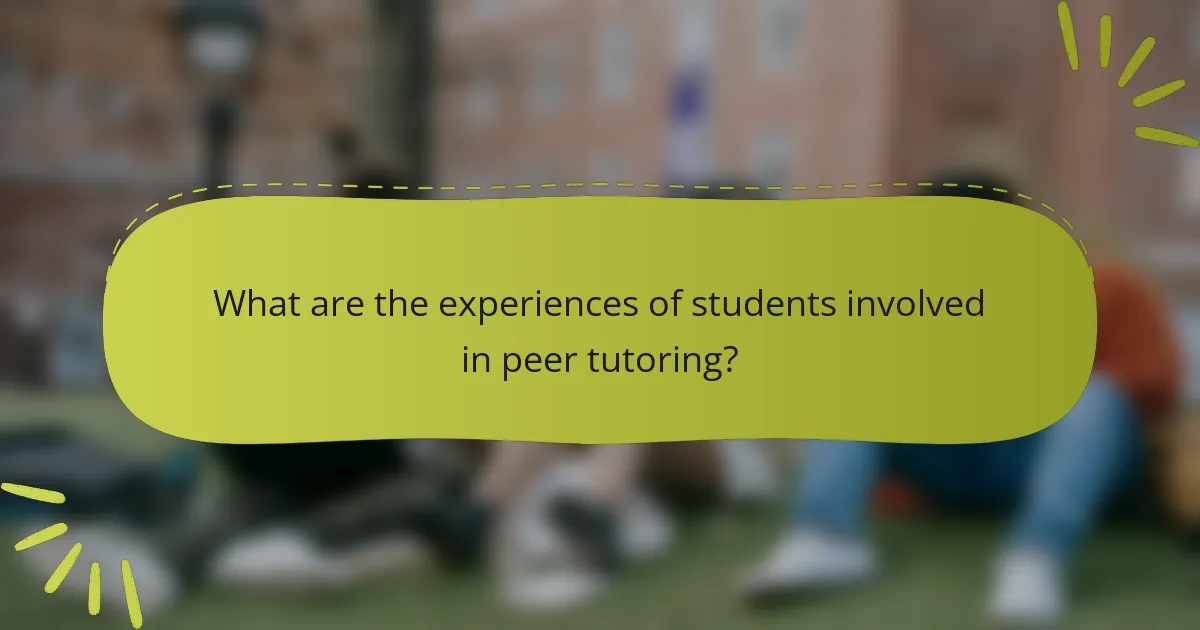
What are the experiences of students involved in peer tutoring?
Students involved in peer tutoring often report positive experiences. They gain a deeper understanding of the subject matter. This is evidenced by improved academic performance in math. Peer tutors frequently develop better communication skills. They learn to explain concepts clearly to their peers. Additionally, students experience increased confidence in their abilities. Research shows that peer tutoring enhances social interactions among students. Participants often feel a sense of accomplishment when helping others. Overall, the experiences are beneficial for both tutors and tutees.
What do students report about their experiences as tutors?
Students report that their experiences as tutors are generally positive. They often feel a sense of accomplishment when helping peers understand difficult concepts. Many students indicate that tutoring enhances their own understanding of the subject matter. They also report improved communication skills as they explain topics to others. Additionally, students appreciate the opportunity to build relationships with their peers through tutoring. Some express that tutoring helps reinforce their learning and boosts their confidence. Research shows that peer tutors often gain valuable leadership skills. Overall, students find tutoring to be a rewarding experience that benefits both themselves and their tutees.
How do tutors perceive their own skill development through tutoring?
Tutors perceive their own skill development through tutoring as a significant enhancement of their teaching and interpersonal abilities. They often report improved communication skills due to the need to explain concepts clearly. Many tutors find that their problem-solving skills increase as they encounter various student challenges. Additionally, tutors frequently recognize growth in their patience and adaptability when working with different learning styles. Research shows that engaging with students fosters a deeper understanding of the subject matter for tutors themselves. A study by Topping (2005) emphasizes that peer tutoring not only benefits students but also enhances tutors’ academic confidence and teaching strategies.
What challenges do peer tutors face in math tutoring sessions?
Peer tutors in math tutoring sessions face several challenges. One significant challenge is varying levels of understanding among students. Tutors must adapt their explanations to meet different comprehension levels. Another challenge is managing time effectively during sessions. Limited time can lead to incomplete coverage of topics. Additionally, peer tutors may struggle with conveying complex concepts clearly. This can result in misunderstandings or confusion among tutees.
Furthermore, peer tutors often lack formal training in teaching strategies. This can hinder their ability to facilitate learning effectively. They may also encounter emotional challenges, such as frustration when students do not grasp concepts quickly. Lastly, maintaining motivation and engagement in sessions can be difficult. Tutors must find ways to keep students interested in the material. These challenges highlight the need for support and training for peer tutors in math.
What feedback do students provide about being tutored?
Students provide positive feedback about being tutored. They often report improved understanding of math concepts. Many students feel more confident in their abilities after tutoring sessions. They appreciate personalized attention and tailored explanations. Peer tutors are frequently seen as relatable and approachable. Students also mention that tutoring sessions help clarify difficult topics. Feedback indicates that students value the supportive learning environment. Overall, many express satisfaction with the tutoring experience.
How do students feel about the effectiveness of peer tutoring in math?
Students generally feel positively about the effectiveness of peer tutoring in math. Many report increased understanding of mathematical concepts through peer interactions. A study by Topping and Ehly (1998) found that students engaged in peer tutoring showed improved academic performance. Additionally, students often express that peer tutors provide relatable explanations. This relatability can enhance engagement and motivation. Surveys indicate that a majority of students prefer learning from peers over traditional instruction. Overall, the consensus among students is that peer tutoring is a beneficial method for improving math skills.
What suggestions do students have for improving peer tutoring programs?
Students suggest several ways to improve peer tutoring programs. They recommend enhancing tutor training to ensure effective teaching methods. Students also advocate for matching tutors with tutees based on learning styles. Regular feedback sessions between tutors and students can help identify areas for improvement. Additionally, incorporating technology for scheduling and communication can streamline the process. Creating a structured curriculum for tutoring sessions can provide consistency. Finally, students emphasize the importance of fostering a supportive and encouraging environment during tutoring. These suggestions can lead to more effective peer tutoring experiences.
What are best practices for implementing peer tutoring in math?
Effective peer tutoring in math involves structured pairing of students. This can enhance understanding and retention of mathematical concepts. Establish clear goals for each tutoring session. These goals should align with curriculum standards. Regular training for tutors is essential to ensure they understand effective teaching strategies.
Monitor progress through assessments to measure improvement. Feedback from both tutors and tutees can help refine the process. Create a supportive environment that encourages questions and collaboration. Lastly, schedule consistent sessions to maintain momentum and build relationships.
How can educators facilitate successful peer tutoring experiences?
Educators can facilitate successful peer tutoring experiences by providing clear guidelines and training for tutors. Establishing a structured framework helps tutors understand their roles. Educators should match tutors and tutees based on skill levels and learning styles. This promotes effective communication and understanding. Regular check-ins can help monitor progress and address challenges. Providing resources and materials can enhance the tutoring sessions. Encouraging feedback from both tutors and tutees fosters improvement. Research shows that structured peer tutoring increases academic performance, particularly in math skills (Roscoe & Chi, 2007).
What resources are available to support peer tutoring in math?
Peer tutoring in math can be supported by various resources. These include online platforms such as Khan Academy and IXL. They offer structured lessons and practice problems. Local schools often provide tutoring programs, connecting students with peers. Community centers may also host tutoring sessions. Teacher resources, like lesson plans and worksheets, enhance peer tutoring effectiveness. Educational apps can facilitate collaborative learning. Research shows that these resources improve math skills and boost confidence. Studies indicate that peer tutoring leads to higher academic performance in math.
The main entity of the article is peer tutoring, specifically its impact on math skills among students. The article outlines how peer tutoring enhances mathematical understanding, problem-solving abilities, and overall academic performance through collaborative learning methods. It discusses specific skills improved through peer tutoring, the influence of different learning styles, and the psychological factors contributing to its effectiveness. Additionally, the article examines the experiences of students involved in peer tutoring, the challenges faced by tutors, and best practices for implementing successful peer tutoring programs in math education.
